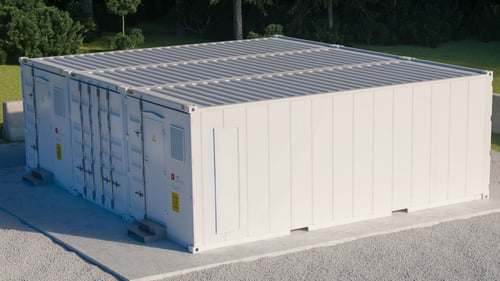Unlocking BESS’ Full Potential: Why Multi-Market Trading is the Future

The Nordics’ battery industry is evolving fast, with larger battery capacities, rising energy demand, and market changes bringing in new revenue opportunities.
European countries are seeing increased electricity consumption and reliance on variable renewable sources to power their energy systems, which amplifies grid volatility and makes flexible storage and multi-market optimisation essential for battery owners and developers. This transformation of traditional revenue models makes the reliance on single-market trading increasingly outdated and brings forward the importance of multi-market optimisation and trading. A key part of multi-market optimisation will come from leveraging wholesale market opportunities, which are growing with the move towards 15-minute trading windows. This offers battery owners and developers diversified revenue streams to increase the speed of their return on investment, all without the risks of a single-market approach.
Jump to:
- The Changing Landscape of Battery Storage in the Nordics
- Navigating the Complexity of Wholesale Markets
- The Lucrative Potential of Intra-Day Trading in the Nordics
- The Importance of a Strong Battery Optimiser
- Embracing the Future of Multi-Market Trading
Evolving Battery Storage in the Nordics
Five years ago, single-market optimisation was the only necessary revenue stream for BESS, as single-market trading on short response frequency markets was profitable enough. Different markets will have different names for these services, with the Nordic electricity markets using FCR-N, FCR-D and FFR to manage short frequency deviations. These markets typically require real-time data connections, specific response profiles and of course fast response times which were the reason why they were initially highly paid services.
Compared to the total size of the electricity market, these short response markets are quite small in size. As a result, initial BESS units that came onto the market started to meet the demand of these small markets and their prices reduced quickly. This has reduced returns for BESS owners trading on those markets but technological improvements have enabled batteries to be traded on multiple markets, which brings new revenue avenues for BESS owners and shifts the focus towards multi-market optimisation.
This shift towards multi-market optimisation can be seen in how BESS units participate in Nordic energy markets. We are seeing units become prequalified and trade on more market programs. This transition represents more than just a diversification of revenue streams but also means that BESS units are supporting the grid in more ways than just the short response frequency. This includes energy-based balancing markets such as aFRR and mFRR which require longer-duration activations to solve market imbalances. The wholesale markets are included as well, being the day-ahead and intraday electricity markets, where BESS can reduce wide spreads in electricity prices across the day. As the Nordic region continues its transition towards renewable energy, this strategic shift in BESS deployment is becoming increasingly critical.
Finland, for example, is on the verge of a major increase in battery demand. As the country continues to electrify and new industries enter the market, energy consumption is expected to double within the next decade. Much of the energy to meet that demand will come from wind power, which is projected to supply 50% of Finland’s electricity by 2030. With this increase in energy comes a need for energy storage.
Comparison of projected electricity consumption and production in Finland, Source: FinGrid
While this transition to renewables is crucial for decarbonisation, it also introduces volatility into the grid. Solar and wind power generation are inherently intermittent, leading to fluctuating electricity prices and frequent imbalances. This creates a long-term need for BESS to provide grid stability by absorbing excess renewable energy and providing during moments of low production. The Finnish market is expected to require deep and numerous batteries to effectively balance the wholesale market, making multi-market optimisation a key strategy for BESS operators looking to maximise long-term revenue.
By shifting between different ancillary markets and wholesale markets, BESS owners and developers would maximise profits while balancing the overall risk of battery degradation. This ensures that batteries are always used in the most efficient way to ensure a higher return on investment.
Navigating the Complexity of Wholesale Markets
One of the most significant opportunities for BESS lies in shorter trading windows on the wholesale market, with some mature markets operating on intervals as short as five minutes. These shrinking windows make BESS trading and optimisation highly competitive, but they also enable operators to capitalise on price fluctuations, optimise across markets, and maximise revenue.
This is no different for Europe, as the continent transitions to a 15-minute trading window in the day-ahead and intraday markets. This shift is driven by the European Union’s Electricity Balancing Guidelines, mandating a 15-minute imbalance settlement period to improve market efficiency and renewable integration. This change is already implemented in several European countries, like Germany and the Netherlands, and is designed to enhance grid flexibility by allowing more granular trading.
The Nordics, under the Nordic Balancing Model, have recently added the 15-minute window for the intraday market, imbalance settlement and thus also the energy markets for aFRR and mFRR. The Nordics' day ahead (DA) markets change to a 15-minute window in June 2025. If the trends of other European countries, like Germany, are replicated, this could increase the average daily spreads in Finland by around 100%.
Comparison of Day Ahead (DA) markets between daily 15min and 60min spreads and averages in Germany, Source: Sympower
These shorter trading intervals mean more volatile prices, as market participants adjust their bids based on real-time fluctuations in supply and demand. This presents a lucrative arbitrage opportunity for BESS operators: batteries can charge during low-price periods and discharge during peak prices, capitalising on price peaks within the 15-minute windows. This will allow operators to make the most of these short arbitrage moments, unlocking greater revenue potential compared to longer trading intervals. As Nordic countries move toward this model, BESS owners who adapt quickly to these changes will be best positioned to capture value in the evolving energy landscape.
The Lucrative Potential of Intra-Day Trading in the Nordics
The Frequency Containment Reserve (FCR) has historically been a cornerstone for batteries in the Nordics, acting as a reliable means to support grid stability while generating consistent revenue for BESS owners and developers. Despite being beneficial, the evolution of BESS in the Nordics has led to greater FCR market saturation. We see the amount of installed BESS units is close to the size of the whole FCR market in Finland and Sweden. Looking at Finland in April 2025, there were on average 300MW (hourly market) of FCR-N and FCR-D Up and Down purchased each hour with 200MW and 255MW of BESS prequalified on FCR-N and FCR-D respectively. This increases the overall competition within FCR markets and decreases overall prices and acceptance rates for BESS owners. We can see this in the declining FCR prices but also in the declining acceptance rates, being the ratio between bids in the market and procured volumes. This is further intensified by other low-cost demand response assets that compete on these markets, like commercial and industrial equipment. Because of this, the natural evolution of trading for BESS lies in deeper trading markets such as aFRR, mFRR as well as the wholesale market, being day ahead and intraday markets.
Intraday is mainly a continuous market with the gate closure being just before delivery unlike the other BESS revenue streams which require bids to be placed hours before. This means that the price for energy at a specific time will change from when the market opens to when the delivery time is. This contrasts with other markets, where there is typically one price per product per delivery time. This makes it easier for BESS owners and developers to take advantage of price peaks and toughs seen in intraday markets. When this is paired with multi-market optimisation, BESS owners and developers can capitalise on the profitability of the intraday market, while relying on the consistency of balancing markets.
A good example of the growth in this market can be seen in Germany, where the growth of solar and wind assets as well as Germany being a ‘hub market’ that interconnects to other European power markets power markets has driven the recent increase in intraday liquidity, so much so that intraday trades now account for approximately 30-35% of all transactions. Of those intraday trades, almost 40% occur in the final 60 minutes of trading.
Intraday trades as a percentage of the total market load, Source: Timera Energy
With the Nordics still getting used to a 15-minute trading window, it’s only a matter of time before they become increasingly sophisticated and deeper in liquidity, following trends seen in other European countries. In order to ensure that a consistent return on investment can be guaranteed, BESS developers and owners will have to adapt to these trends. However, multi-market optimisation comes with its challenges: managing battery cycle limits, choosing what markets to participate in, and the opportunity cost that comes from reserving capacity for sudden market peaks, must all be balanced.
Successfully managing multi-market optimisation requires advanced algorithms, machine learning models, and a specialised team with deep energy market expertise. A reliable battery optimiser ensures the swift execution of processes like prequalification and ongoing communication with the Transmission System Operator (TSO), preventing delays that could reduce availability and impact returns. While multi-market trading offers greater revenue potential, success depends on working with an experienced route-to-market optimiser who can navigate short-term fluctuations and long-term market trends. Partnering with the right experts ensures efficient trading, maximised profitability, and a strong long-term return on investment.
Embracing the Future of Multi-Market Trading
Europe is primed for a massive shift in how BESS operates, and BESS operators must go beyond short-term balancing by adopting a multi-market approach to succeed in this evolving landscape. Maximising returns requires expert optimisation, real-time decision-making, and deep market knowledge: embracing this strategy today will position BESS owners and developers for long-term profitability in tomorrow’s energy markets.
Download our brochure today to discover how our expertise in multi-market optimisation can help you maximise your BESS potential and secure long-term revenue.
Turn your stored energy into profit.
Discover how integrating Battery Energy Storage Systems (BESS) with Demand Response strategies can revolutionise energy management.
Other articles you might find interesting
-
.jpg?length=500&name=electric%20boiler%20(1).jpg) BESS11 June 2025
BESS11 June 2025Beyond revenue potential: navigating the technical complexities of BESS optimisation
Read more -
 BESS11 June 2025
BESS11 June 2025Maximise Battery Revenue: How to Build a Successful Business Case
Read more -
 BESS11 June 2025
BESS11 June 2025The Greek BESS Opportunity: One Market Won’t Do
Read more -
 BESS11 June 2025
BESS11 June 2025Maximising BESS Earnings: 5 Key Revenue Models
Read more -
 BESS11 June 2025
BESS11 June 2025Harnessing BESS’ Potential in the Nordics: Key Insights from our Webinar
Read more -
 BESS11 June 2025
BESS11 June 2025What is Battery Storage?
Read more